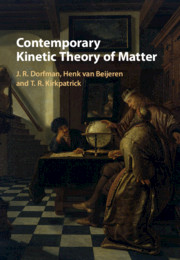Book contents
- Frontmatter
- Dedication
- Contents
- List of Figures
- List of Tables
- Acknowledgements
- Nomenclature
- 1 Introduction
- 2 The Boltzmann Equation 1: Fundamentals
- 3 The Boltzmann Equation 2: Fluid Dynamics
- 4 Transport in Dilute Gas Mixtures
- 5 The Dilute Lorentz Gas
- 6 Basic Tools of Nonequilibrium Statistical Mechanics
- 7 Enskog Theory: Dense Hard-Sphere Systems
- 8 The Boltzmann–Langevin Equation
- 9 Granular Gases
- 10 Quantum Gases
- 11 Cluster Expansions
- 12 Divergences, Resummations, and Logarithms
- 13 Long-Time Tails
- 14 Transport in Nonequilibrium Steady States
- 15 What’s Next
- Bibliography
- Index
2 - The Boltzmann Equation 1: Fundamentals
Published online by Cambridge University Press: 18 June 2021
- Frontmatter
- Dedication
- Contents
- List of Figures
- List of Tables
- Acknowledgements
- Nomenclature
- 1 Introduction
- 2 The Boltzmann Equation 1: Fundamentals
- 3 The Boltzmann Equation 2: Fluid Dynamics
- 4 Transport in Dilute Gas Mixtures
- 5 The Dilute Lorentz Gas
- 6 Basic Tools of Nonequilibrium Statistical Mechanics
- 7 Enskog Theory: Dense Hard-Sphere Systems
- 8 The Boltzmann–Langevin Equation
- 9 Granular Gases
- 10 Quantum Gases
- 11 Cluster Expansions
- 12 Divergences, Resummations, and Logarithms
- 13 Long-Time Tails
- 14 Transport in Nonequilibrium Steady States
- 15 What’s Next
- Bibliography
- Index
Summary
Boltzmann’s transport equation for a dilute gas with particles interacting with central, short range forces, and with bounding walls, is derived in detail, with emphasis on the use of the Stosszahlansatz. Boltzmann’s H–theorem is presented as a microscopic derivation of the law of entropy increase in non–equilibrium processes, and the Maxwell–Boltzmann equilibrium distribution is derived. Zermelo’s and Loschmidt’s arguments that the H–theorem is incompatible with the laws of mechanics are given and discussed. The Kac ring model is presented and used as a simple way to understand the application and the limitations of the Stosszahlansatz. It is concluded that the Boltzmann equation is statistical, rather than strictly mechanical, in nature, providing a description of the most probable non–equilibrium behavior of a dilute gas.
Keywords
- Type
- Chapter
- Information
- Contemporary Kinetic Theory of Matter , pp. 19 - 59Publisher: Cambridge University PressPrint publication year: 2021
- 1
- Cited by

